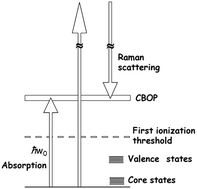Features of chemical bonds based on the overlap polarizabilities: diatomic and solid-state systems with the frozen-density embedding approach†
Abstract
The chemical bond overlap properties were obtained for alkali halides NaY (Y = F, Cl, Br), alkaline-earth chalcogenides MX (M = Ca, Mg and X = O, S, Se) and alkali and alkali-earth metals (Li, Na, and Mg) in diatomic and solid-state systems using an embedding approach based on the frozen density functional theory to simulate the crystalline effects. The computational protocol established provides errors for bond distances smaller than 1%. The results indicate that larger chemical bond covalency leads to larger absorption or scattering by the overlap region. The ionic specific valence and overlap polarizability are closely related to the valence orbital compactness measured by the sum of Mulliken electronegativities. The embedding approach used in this work makes it possible to quantify the effects of the crystalline environment on the chemical bond overlap properties. In the solid-state, the bond overlap charges are less polarizable, in cases of well-known ionic systems (provided by electronegativity differences), leading to smaller chemical bond covalency in solids than in diatomics. The spectroscopic properties of the polarizability of the electron density in the overlap region of a chemical bond could be measured in the 1–20 eV spectral region and could be used to characterize some bands in several spectra whose assignments are ambiguous or not available.


 Please wait while we load your content...
Please wait while we load your content...